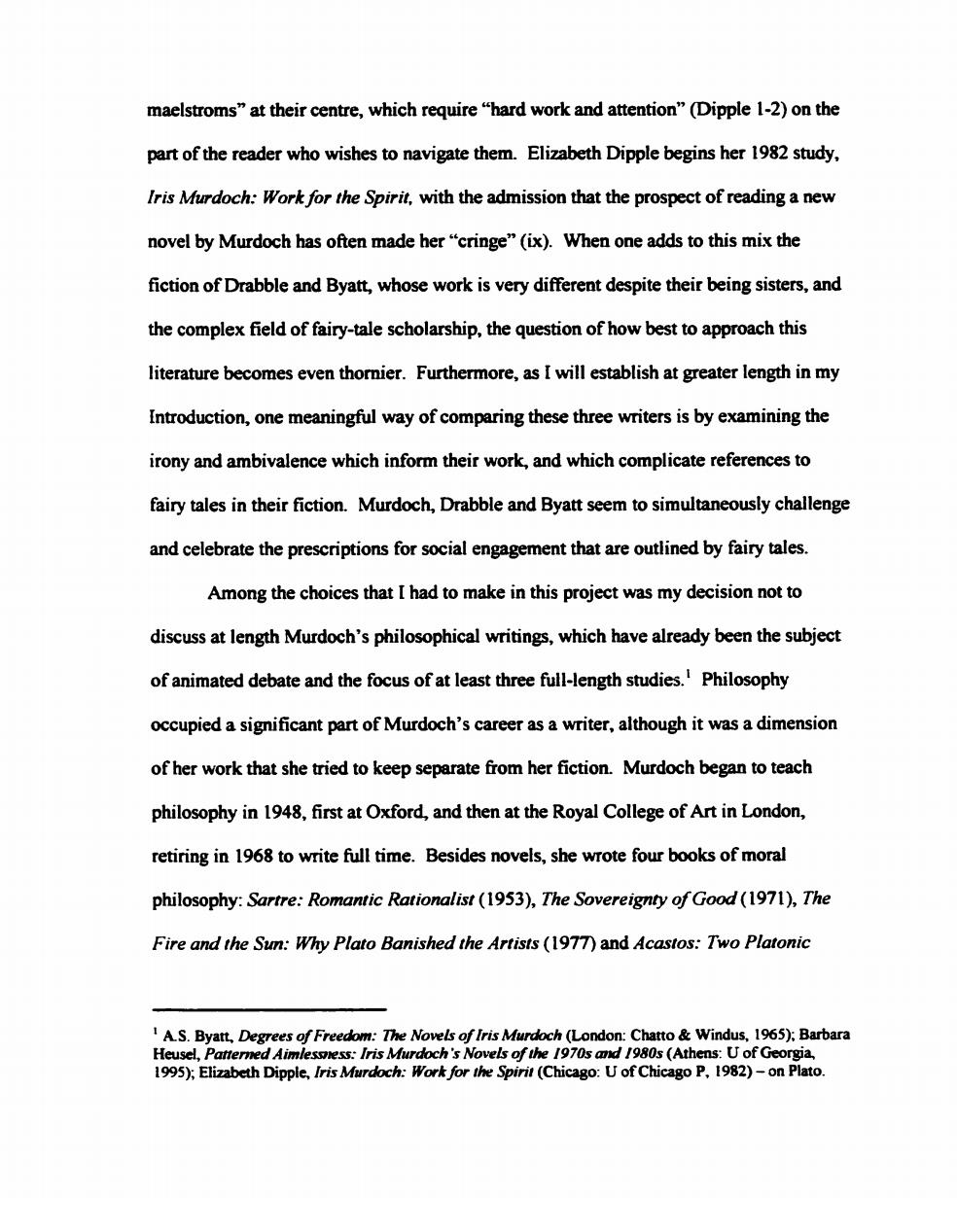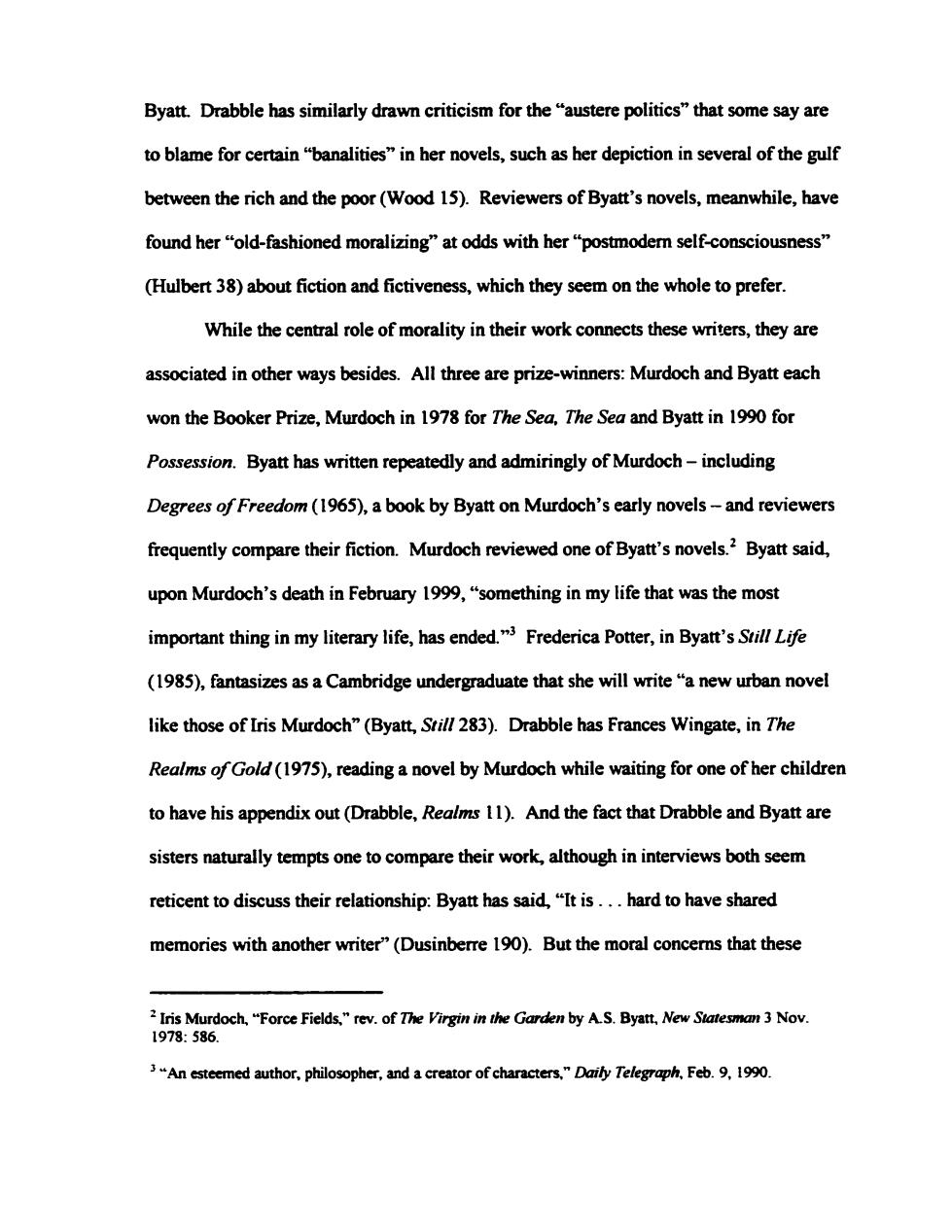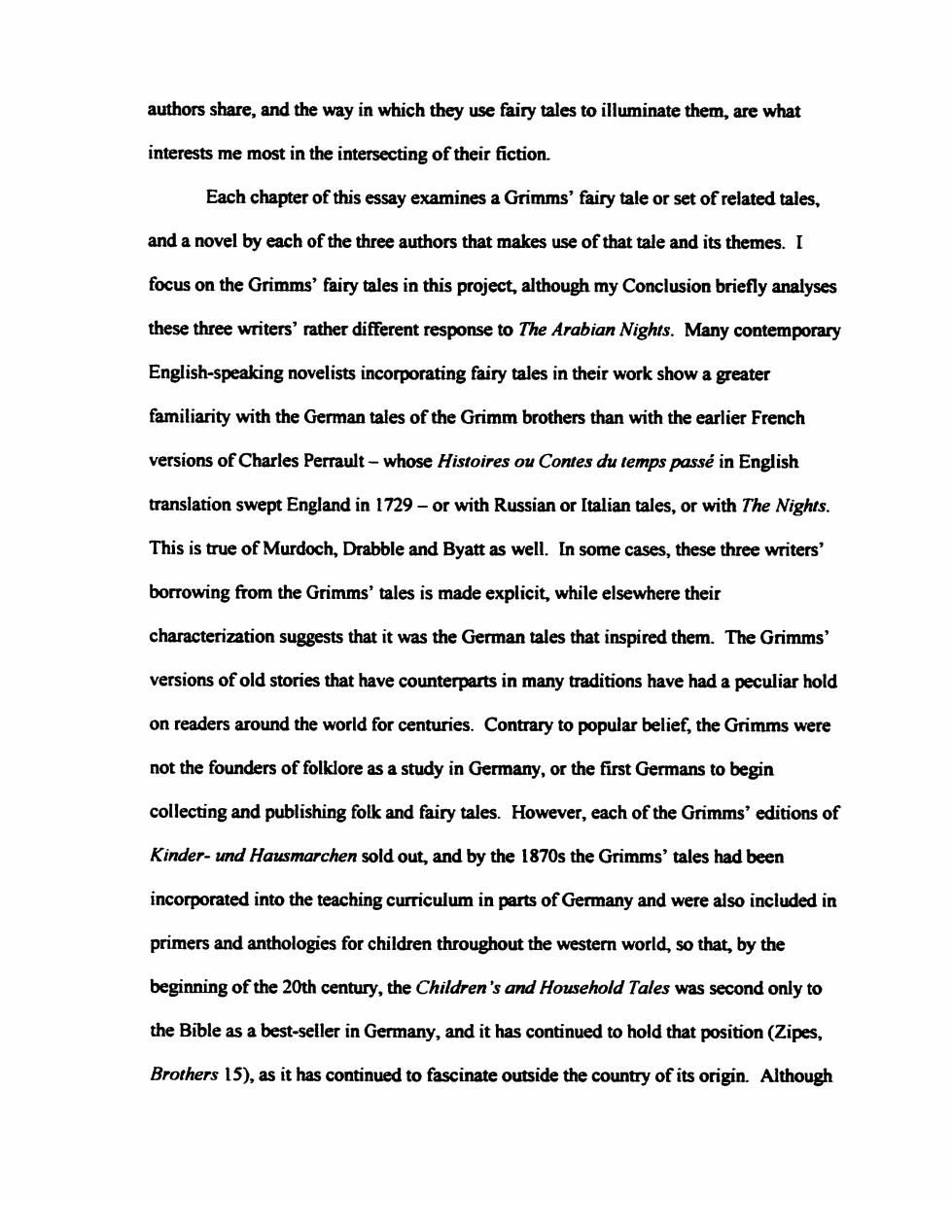
maelstroms"at their centre,which require"hard work and attention"(Dipple 1-2)on the part of the reader who wishes to navigate them.Elizabeth Dipple begins her 1982 study Iris Murdoch:Work for the Spirit,with the admission that the prospect of reading a new novel by Murdoch has often made her"cringe"(ix).When one adds to this mix the fiction of Drabble and Byatt,whose work is very different despite their being sisters,and the complex field of fairy-tale scholarship,the question of how best to approach this literature becomes even thornier.Furthermore,as I will establish at greater length in my Introduction,one meaningful way of comparing these three writers is by examining the irony and ambivalence which inform their work,and which complicate references to fairy tales in their fiction.Murdoch,Drabble and Byatt seem to simultaneously challenge and celebrate the prescriptions for social engagement that are outlined by fairy tales. Among the choices that I had to make in this project was my decision not to discuss at length Murdoch's philosophical writings,which have already been the subject of animated debate and the focus of at least three full-length studies.Philosophy occupied a significant part of Murdoch's career as a writer,although it was a dimension of her work that she tried to keep separate from her fiction.Murdoch began to teach philosophy in 1948,first at Oxford,and then at the Royal College of Art in London, retiring in 1968 to write full time.Besides novels,she wrote four books of moral philosophy:Sartre:Romantic Rationalist(1953),The Sovereignty of Good(1971),The Fire and the Sun:Why Plato Banished the Artists (1977)and Acastos:Two Platonic A.S.Byatt,Degrees of Freedom:The Novels of Iris Murdoch (London:Chatto Windus,1965):Barbara Heusel,Patterned Aimlessness:Iris Murdoch's Novels of the 1970s and 1980s (Athens:U of Georgia, 1995);Elizabeth Dipple,Iris Murdoch:Work for the Spirit (Chicago:U of Chicago P.1982)-on Plato

Dialogues(1987).Murdoch said that her fiction had been influenced by Sartre and Wittgenstein,as well as by Plato,Kant and Simone Weil. However,her critics have called for a distancing of Murdoch's philosophy from her novels,as has the author herself.Elizabeth Dipple has said that"criticism of her novels must,I think,break loose from the compelling frame Murdoch has given"(Dipple 37).Peter Conradi has outlined for Murdoch scholars"[t]he necessary job of discriminating between her works,"arguing that"the work is not an illustration of theory, though it may well comment on it"(Conradi 257).Deborah Johnson offers her opinion that all of Murdoch's novels"pose their own questions and do not need to be explained with reference to some supposedly more authoritative text"(Johnson 3).Murdoch herself said that"I mention philosophy sometimes in the novels because I happen to know about it,just as another writer might talk about coal mining,"but that"I don't want philosophy,as such,to intrude into the novel world at all and I think it doesn't"(Biles 116).She argued,"My novels are not'philosophical novels""(Meyers 217). Although it can be argued that her philosophical studies are not essential to an understanding of her novels,Murdoch's emphasis on moral concems in her fiction has certainly alienated some readers.Lindsay Tucker recognizes that Murdoch's preoccupation with“"banalities”like“goodness'”may"“seem out of place in this postmodern age"(Tucker 9).Murdoch scholars have on occasion found her"moral probings"to be"tedious and pretentious"(Fletcher 26).Murdoch's focus on community, and on the moral life made possible by relationships among people,at a time when British fiction would seem to have lost interest in moral considerations,forges the most important connection between her and two other British women novelists-Drabble and

Byatt.Drabble has similarly drawn criticism for the"austere politics"that some say are to blame for certain"banalities"in her novels,such as her depiction in several of the gulf between the rich and the poor(Wood 15).Reviewers of Byatt's novels,meanwhile,have found her"old-fashioned moralizing"at odds with her"postmodern self-consciousness" (Hulbert 38)about fiction and fictiveness,which they seem on the whole to prefer While the central role of morality in their work connects these writers,they are associated in other ways besides.All three are prize-winners:Murdoch and Byatt each won the Booker Prize,Murdoch in 1978 for The Sea,The Sea and Byatt in 1990 for Possession. Byatt has written repeatedly and admiringly of Murdoch-including Degrees of Freedom(1965),a book by Byatt on Murdoch's early novels-and reviewers frequently compare their fiction.Murdoch reviewed one of Byatt's novels.2 Byatt said, upon Murdoch's death in February 1999,"something in my life that was the most important thing in my literary life,has ended."3 Frederica Potter,in Byatt's Still Life (1985),fantasizes as a Cambridge undergraduate that she will write"a new urban novel like those of Iris Murdoch"(Byatt,Still 283).Drabble has Frances Wingate,in The Realms of Gold(1975),reading a novel by Murdoch while waiting for one of her children to have his appendix out(Drabble,Realms 11).And the fact that Drabble and Byatt are sisters naturally tempts one to compare their work,although in interviews both seem reticent to discuss their relationship:Byatt has said,"It is...hard to have shared memories with another writer"(Dusinberre 190).But the moral concerns that these 2 Iris Murdoch,"Force Fields,"rev.of The Virgin in the Garden by A.S.Byatt,New Statesman 3 Nov. 1978:586. 3"An esteemed author,philosopher,and a creator of characters,"Daily Telegraph,Feb.9,1990

authors share,and the way in which they use fairy tales to illuminate them,are what interests me most in the intersecting of their fiction. Each chapter of this essay examines a Grimms'fairy tale or set of related tales, and a novel by each of the three authors that makes use of that tale and its themes.I focus on the Grimms'fairy tales in this project,although my Conclusion briefly analyses these three writers'rather different response to The Arabian Nights.Many contemporary English-speaking novelists incorporating fairy tales in their work show a greater familiarity with the German tales of the Grimm brothers than with the earlier French versions of Charles Perrault-whose Histoires ou Contes du temps passe in English translation swept England in 1729-or with Russian or Italian tales,or with The Nights. This is true of Murdoch,Drabble and Byatt as well.In some cases,these three writers' borrowing from the Grimms'tales is made explicit,while elsewhere their characterization suggests that it was the German tales that inspired them.The Grimms' versions of old stories that have counterparts in many traditions have had a peculiar hold on readers around the world for centuries.Contrary to popular belief,the Grimms were not the founders of folklore as a study in Germany,or the first Germans to begin collecting and publishing folk and fairy tales.However,each of the Grimms'editions of Kinder-und Hausmarchen sold out,and by the 1870s the Grimms'tales had been incorporated into the teaching curriculum in parts of Germany and were also included in primers and anthologies for children throughout the western world,so that,by the beginning of the 20th century,the Children's and Household Tales was second only to the Bible as a best-seller in Germany,and it has continued to hold that position(Zipes, Brothers 15),as it has continued to fascinate outside the country of its origin.Although

all fairy-tale traditions involve sex and violence to some degree,the particularly bloody violence of the Grimms'tales has made them more interesting for some audiences,as I discuss at greater length in my Introduction to this essay. Among the many versions of the Grimms'fairy tales available,I chose to base this study on folklorist Jack Zipes's 1987 translation for Bantam,The Complete Fairy Tales of the Brothers Grimm.Zipes has published eight books of critical readings of fairy tales that focus on the Grimms-scholarship which has also been useful to this project.Therefore,he is obviously sensitive to the demands of the material.He indicates in his notes that his goal in translating was to make the stories "historically more accurate"than they are in other translations.Zipes's version is based on the final, seventh edition of the Grimms Kinder-und Hausmarchen,published in 1857.But he adds to these tales translations of thirty-two others that were omitted by the Grimms from the 1857 version,after they had been printed in earlier editions.Thus,every tale that has appeared in print under the Grimms'direction is featured in Zipes's translation.The extra tales include"Bluebeard,"which the Grimms omitted from later editions"on the grounds that it showed too many signs of its French origins"(Tatar,Hard 157),according to Maria Tatar.I find the tale no less interesting or deserving of discussion,knowing that the Grimms changed their mind about it after publication.The Grimms'variant of "Bluebeard,"and other German tales that resemble it,are discussed in Chapter Three of this essay.Zipes indicates how scrupulous he has been in his translation when he notes Jack Zipes,"A Note on the Translation,"The Complete Fairy Tales of the Brothers Grimm,trans.Zipes (1987;New York:Bantam,1992)xoxxii